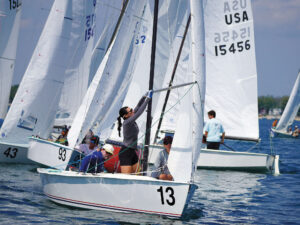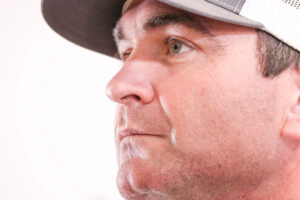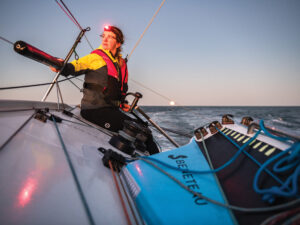
AC34 Mods and Modifications
One of the major differences between this 34th America’s Cup and other modern day Cup cycles is the extent to which the design teams have remained actively involved in honing the performance of the boats once racing began. All four of the teams involved have seen major performance gains as they changed things based on data gathered during live racing and what they observed of their opposition.
“In previous Cups you have either had a heavy-air boat or a light-air boat, and once you roll the dice, that’s it and you can’t respond,” explains senior Oracle Team USA design team member Dirk Kramers.
Kramers firmly believes that the ability to make changes to improve performance once racing has begun adds to the excitement of the sport.
“Being able to see if you can come back adds to the game,” he says. “It’s like in a football game, you change a few players and you rearrange things; or in a car race you change the suspension set up or the aerodynamic set up, and you can get back in the game.”
According to Kramers, the adoption of high-performance multihulls has meant that the subtlest of tweaks can result in a profound performance gain.
“That’s the beauty of the multihulls, they are sensitive to very slight changes, and you can really change the boat quite dramatically, as you have seen, with relatively modest changes.
“We have been on a steep learning curve throughout this whole process, and we are still learning things on a daily basis. Fortunately the rules are such that we can adapt the boats mid-regatta so that we can correct errors that were made in the process. That helps keep the competition exciting.”
After some aggressive modifications made during the 34th America’s Cup Final series itself, Oracle’s boat surprisingly emerged as the perceived better performer in the stronger winds, particularly upwind.
This newfound heavy-air superiority is something Emirates Team New Zealand design team boss Nick Holroyd finds ironic when he thinks back to before the Cup match began.
“Back then,” he says with a twinkle. “we were pushing for the wind limits to go up, and they were probably pushing them down. Maybe the shoes are on the respective opposite feet now.”
According to ETNZ helmsman Dean Barker, Holroyd’s team have done a good job at finding ways to match Oracle’s newfound speed on the beats, and he believes the two boats are now all but even in performance around the course.
“Like the Oracle guys we are not standing still either,” Barker says. “We are working very hard with improvements to the boat. We have done some sailing against these guys in different conditions and certainly in the top end of the wind range we think we needed to improve the performance. We are pretty happy with the changes that we made.
“To believe it would be this close between two teams with pretty different design concepts is hard to believe. They both have strengths and weaknesses, but both teams have reacted very well to what they have observed of the other team, and I think the two boats have more or less come together in terms of performance.
“Unbelievably in the first generation of the class you have got two boats that are this close in performance over a variety of conditions,” Barker concludes.
Both Holroyd and Kramers agree that the new course layouts for this America’s Cup meant that they had initially focused their search for speed on the downwind legs.
“Because of the course geometry with long downwinds, our design theory was based around downwind speed being really important,” Holroyd explains. “The foiling strategy that we went down is largely as a result of that.”
Now, both teams have switched their attention to eking out extra knots on the single upwind leg–a fact that Holroyd actually puts down to the parity of the teams’ downwind performance.
“The boats are actually way faster in both directions than we ever envisaged at the start of the campaign,” he says.
“The emphasis that we are now seeing on upwind speed is as a result of the fact that both teams are going so fast downwind and very, very evenly. So now the differences in the contest are focused on upwind.”
“One of Oracle’s key features was always how to get to the bottom mark first,” says Kramers. “Because if there is a difference in speed upwind then you can defend it if you get to the bottom mark first. That would hold good for any type of boat, but the differences we can make on these boats are much, much larger.”
Many of the talked about modifications the teams make are to do with the ‘moding’ of the boats–but what does that actually mean?
Holroyd explains it like this:
“At the end of the day there are a set of forces acting on the boat, and any time you generate lift there is a certain amount of drag that comes along with it,” he says. “So we are looking closely at those equations and how, for a specific windspeed, we generate those forces most efficiently. That’s moding.”
Despite the Kiwis needing only one more point to win the America’s Cup when I spoke to Holroyd, he said there had been no slackening in the quest to make their boat go faster–particularly with unfamiliar sub-15 knot winds forecast for Thursday and rest of this week.
“You try not to get too bound up in the high at the moment, as we still need to be able to make good unemotionally-based decisions; as we go through this week and develop the boat that is really important,” he says.
“The thing that we have done really well as a team is the fantastic conversation that we have always had between our design and sailing team that came out of our small boat testing.
“We are focused on keeping the processes that we have as a group working smoothly so that we can keep on making good decisions and then see how it plays out.”
Read an interview with an Oracle Team USA shore crew member.









